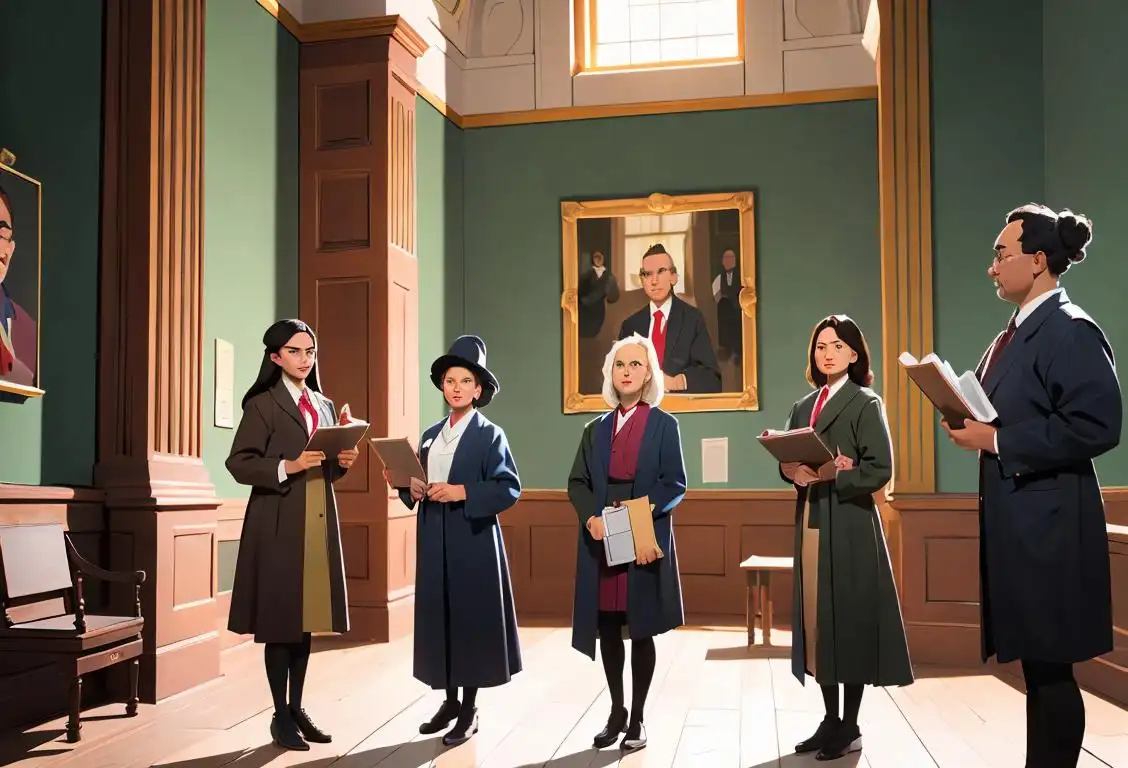National Bill Of Rights Day

Are you ready to exercise your rights and celebrate National Bill of Rights Day? Get ready to dive into the fascinating history of this important day and discover why it's worth celebrating!
When is Bill Of Rights Day?
It's national bill of rights day on the 15th December.
The Birth of the Bill of Rights
On this special day, we commemorate the ratification of the Bill of Rights to the United States Constitution on December 15, 1791. The Bill of Rights, consisting of the first ten amendments, establishes and protects the rights and liberties of American citizens.
Back in the late 18th century, the Founding Fathers realized that a framework was required to safeguard personal freedoms and limit the power of the government. They diligently worked on drafting these ten amendments, which were finally ratified by three-fourths of the states, securing its place in history and making America a beacon of liberty.
Recognizing Our Rights
One of the essential aspects of National Bill of Rights Day is to promote awareness of the importance of our individual freedoms. It's an opportunity for citizens to educate themselves and others about their rights and understand the impact these rights have on their lives and society as a whole. Whether it's freedom of speech, religion, or the right to bear arms, the Bill of Rights forms the cornerstone of our democratic society.
Furthermore, National Bill of Rights Day serves as a reminder that these rights should never be taken for granted. It's a day to encourage open dialogue, debate, and the proper utilization of our constitutional rights. So, take a moment to reflect on the freedoms we enjoy and the responsibilities that come with them.
Did You Know?
Did you know that the Bill of Rights almost didn't happen? When the Constitution was first adopted, it did not include specific protections for individual rights. However, due to the insistence of several influential figures, such as James Madison and Thomas Jefferson, the Bill of Rights was eventually added as amendments!
History behind the term 'Bill Of Rights'
1215
The Magna Carta
In the year 1215, King John of England signed the Magna Carta, a historic document that established certain rights and privileges for the nobility and limited the power of the monarchy. While not explicitly called a 'bill of rights,' the Magna Carta laid the foundation for the concept by granting individuals protections such as due process and the right to a fair trial.
1215
Magna Carta
In the year 1215, the Magna Carta was signed by King John of England. This historic document was a charter of liberties that granted certain rights to the English barons and limited the power of the monarchy. Although it did not include a formal 'Bill of Rights,' it set a precedent for the protection of individual liberties.
1215
Magna Carta
The history of the term 'bill of rights' can be traced back to the Magna Carta, a famous document that was signed in 1215. This historic charter established the concept of individual rights and limited the power of the English monarchy. Although the term 'bill of rights' was not specifically used in the Magna Carta, it laid the foundation for future legal documents that would incorporate the concept.
1215
Magna Carta Establishes Principles
In the year 1215, King John of England agreed to sign the Magna Carta, a document that established the principle that the king was not above the law. The Magna Carta granted certain rights and liberties to the English nobility and limited the power of the monarchy. Although it did not explicitly mention a 'bill of rights,' the Magna Carta laid the foundation for the concept.
1215
Magna Carta
In the year 1215, the Magna Carta, also known as the Great Charter, was issued by King John of England. This document established certain fundamental rights and liberties of the English people. Although it did not formally use the term 'bill of rights,' it laid the foundation for the concept by limiting the powers of the monarch and recognizing the rights of the barons.
1689
English Bill of Rights
In 1689, the English Bill of Rights was enacted following the Glorious Revolution. It secured important rights for English citizens, such as freedom of speech, the right to a fair trial, and the prohibition of cruel and unusual punishment. This landmark document served as an inspiration for later bills of rights in other countries, including the United States.
1689
The English Bill of Rights
In 1689, the English Bill of Rights was enacted, inspired by the tumultuous political climate and the desire to preserve individual liberties. It established crucial rights for Parliament and regular citizens, such as the right to petition, the right to bear arms, and protection against cruel and unusual punishment. This document laid the groundwork for future bills of rights around the world.
1689
English Bill of Rights
In 1689, the English Bill of Rights was enacted following the Glorious Revolution in England. This important document not only established the rights and liberties of the English people but also limited the powers of the monarchy. The English Bill of Rights influenced the concept of the 'Bill of Rights' in other countries, including the United States.
1689
English Bill of Rights
In 1689, the English Parliament passed the English Bill of Rights, which was a landmark document in British constitutional history. The bill clarified and reinforced the rights and liberties of the individual and established restrictions on the monarchy. It guaranteed freedom of speech, the right to a fair trial, and protection against excessive bail and cruel punishments, among other rights. The English Bill of Rights served as an inspiration for future bills of rights in other countries, including the United States.
1689
English Bill of Rights
In 1689, the English Parliament passed the English Bill of Rights. This influential document was enacted following the Glorious Revolution and replaced the previous rule of James II with William III and Mary II. The English Bill of Rights served as a precursor to the modern concept of a bill of rights, as it outlined personal liberties and laid the groundwork for constitutional law.
1776
Virginia Declaration of Rights
The year 1776 witnessed the adoption of the Virginia Declaration of Rights by the Virginia Convention. Authored primarily by George Mason, this document proclaimed fundamental rights and principles that should be protected in a just society. Its influence was significant as it heavily influenced the drafting of the United States Bill of Rights.
1776
Virginia Declaration of Rights
The year 1776 marked the adoption of the Virginia Declaration of Rights. This influential document, drafted by George Mason, served as a model for the later Bill of Rights in the United States. It outlined fundamental rights such as freedom of speech, religion, and the right to a fair trial, inspiring the inclusion of similar rights in the U.S. Constitution.
1776
Virginia Declaration of Rights
The term 'bill of rights' gained prominence in 1776 with the drafting of the Virginia Declaration of Rights. Authored by George Mason, this document became the inspiration for future iterations, including the United States Bill of Rights. The Virginia Declaration of Rights emphasized the protection of individual rights, such as freedom of speech, religion, and the right to a fair trial.
1776
Virginia Declaration of Rights
In the year 1776, the Virginia Convention adopted the Virginia Declaration of Rights, a document that influenced the drafting of the United States Constitution and Bill of Rights. The Virginia Declaration of Rights, written by George Mason, emphasized the inherent rights of citizens, including freedom of the press, religious freedom, and the right to trial by jury. It served as a precursor to the national bill of rights that would be added to the U.S. Constitution a few years later.
1776
Virginia Declaration of Rights
In 1776, the Virginia Declaration of Rights was adopted as part of the movement towards independence in the American colonies. Crafted primarily by George Mason, this influential document proclaimed fundamental rights, including freedom of speech, the right to a fair trial, and protection against excessive bail or fines. The Virginia Declaration of Rights served as a template for future bills of rights, including the United States Bill of Rights.
1789
United States Bill of Rights
In 1789, the United States Bill of Rights was ratified as the first ten amendments to the Constitution of the United States. Proposed by James Madison, these amendments aimed to protect individual liberties and limit the power of the federal government. The Bill of Rights enshrined crucial rights such as freedom of religion, freedom of the press, the right to a fair trial, and protection against unreasonable searches and seizures.
1789
U.S. Bill of Rights
On December 15, 1791, the United States ratified the Bill of Rights. Proposed by James Madison, the Bill of Rights consists of the first ten amendments to the U.S. Constitution. It guarantees fundamental rights such as freedom of speech, assembly, and religion, the right to bear arms, protection against unreasonable searches and seizures, and the right to a fair trial. The U.S. Bill of Rights has been a cornerstone of American democracy and has influenced the development of human rights around the world.
1787
United States Constitution
In 1787, the United States Constitution was drafted during the Constitutional Convention. It did not initially include a specific Bill of Rights. However, there was a growing demand from the states for the protection of individual rights. To ensure the ratification of the Constitution, a compromise was reached, and the promise of a 'Bill of Rights' was added as the first ten amendments in 1791.
1789
United States Bill of Rights
In 1789, following the ratification of the United States Constitution, the United States Bill of Rights was added as its first ten amendments. This historic document guarantees essential individual liberties, such as freedom of religion, speech, and the right to bear arms. It remains a pillar of the American legal system and has inspired countless nations around the world in creating their own bills of rights.
1789
United States Bill of Rights
The most well-known example of a bill of rights is the United States Bill of Rights, which was adopted in 1789. It comprises the first ten amendments to the U.S. Constitution and guarantees fundamental freedoms and protections for American citizens. These rights include freedom of speech, religion, assembly, and the right to bear arms. The United States Bill of Rights has since become a model for bill of rights around the world.
1791
Ratification of the Bill of Rights
In 1791, the Bill of Rights was ratified, incorporating the first ten amendments to the United States Constitution. These amendments safeguarded essential rights such as freedom of speech, religion, and the right to bear arms. The Bill of Rights has since become a cornerstone of American democracy and a model for similar documents worldwide.
Did you know?
Fun fact: The original Bill of Rights document consists of just 7,591 words, while an average episode of a popular TV series can contain around 20,000 words!Tagged
awareness celebration historyFirst identified
15th December 2015Most mentioned on
15th December 2016Total mentions
223Other days
Swiss Day
Parents Day
Senior Citizens Day
Album Day
Caramel Day
Lasagna Day
Martini Day
Vodka Day
Bourbon Day
Gin Day









